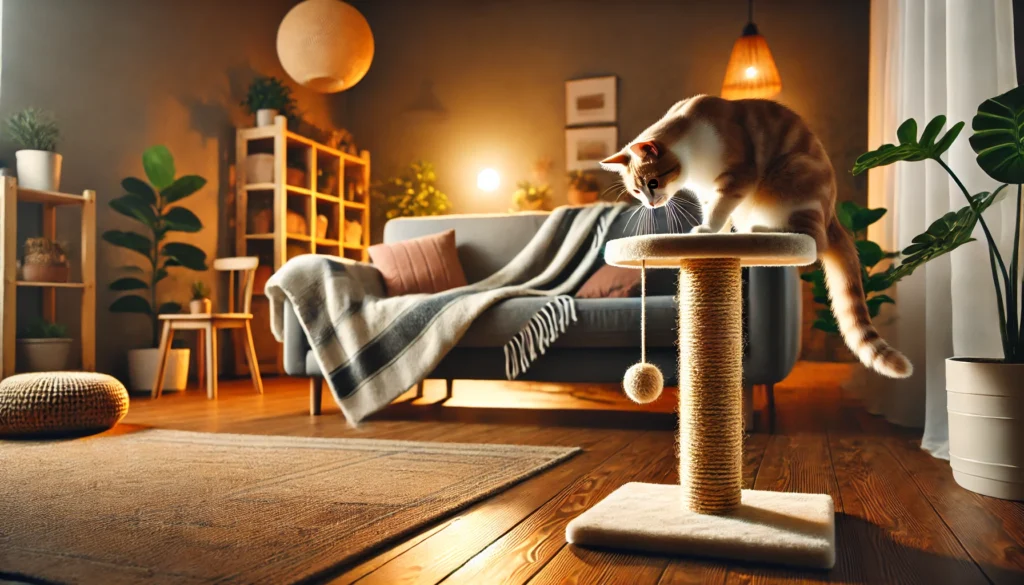Bringing a cat into your home can be one of life's most rewarding experiences, however, it can also come with some challenges. One of the most common problems faced by cat owners is furniture scratching behavior.
This natural feline habit, although healthy for them, can be a nightmare for our furniture. But with patience and some smart strategies, you can teach your cat to redirect its scratching instincts to appropriate locations. Let's explore together best practices for training your cat and protecting your precious furniture.
Understanding Cat Behavior
First of all, it is essential to understand why cats scratch. They scratch to mark territory, sharpen their claws, stretch and exercise. By understanding the motivations behind this behavior, we can approach the issue with more empathy and effectiveness. Cats have scent glands on their paws, which release a unique scent when they scratch, communicating their presence to other cats.
Provide Compelling Alternatives
To divert attention away from furniture, it's crucial to provide attractive alternatives. Scratchers and posts are excellent options. Place them strategically near furniture your cat tends to scratch. This way, your feline can easily be redirected to these items.
Choosing the Right Scratcher
Choosing the right scratching post makes a big difference. Observe your cat's habits: does he prefer to scratch vertically or horizontally? There are scratching posts of various shapes and materials, from traditional posts covered in sisal to horizontal ones made of cardboard. Offering a variety can help you discover what your cat likes best.

Use of Attractants and Positive Reinforcements
To make scratching posts more attractive, use attractants like catnip (catnip) or toys. Reward your cat with treats or cuddles whenever he uses the scratching post, positively reinforcing the desired behavior. This creates a positive association with using the scratching post.
Furniture Protection
While your cat is still learning, securing furniture might be a good idea. Products like double-sided tape can be effective, as cats don't like the sticky feeling on their paws. Protective covers or specific fabrics can also be used temporarily to protect valuable surfaces.
Negative Reinforcement Training
Although positive reinforcement is generally more effective, in some cases, negative reinforcement may be necessary. A common approach is to use a water spray when your cat is caught scratching furniture. However, you must use this technique carefully so as not to scare or cause stress to the cat.
Consistency is the Key
Cat training requires consistency. Everyone in the house must follow the same rules and methods. If one person allows the cat to scratch the couch while another does not, the cat will be confused and the training will be ineffective.
Adequate Stimulation and Exercise
Bored or energetic cats are more likely to scratch furniture. Make sure your cat has adequate toys and opportunities to play and exercise. Regular play sessions help to use up accumulated energy.
Understanding Stress and Anxiety
Some cats scratch more when they are stressed or anxious. Changes in the environment, such as the arrival of a new animal or changes in routine, can trigger destructive behaviors. Identifying and addressing the causes of stress can significantly reduce furniture scratching.
Using Professional Help
If all attempts fail, do not hesitate to seek professional help. Veterinarians and animal behaviorists can offer personalized solutions and techniques to address specific behavioral problems.
Creating an Enriched Environment
An enriched environment is essential for the mental and physical health of cats. Add shelves, scratching posts and toys in different areas of the house to encourage your cat to explore and scratch in appropriate places. Environmental enrichment reduces boredom and provides the physical and mental stimulation needed to keep your cat happy and healthy.
Educating the Family
Make sure everyone in the house understands the importance of redirecting scratching behavior. This includes teaching children how to interact appropriately with cats and the importance of not allowing scratching on furniture. Everyone's education and collaboration are crucial to the success of the training.
Monitoring and Adjustments
Monitoring your cat's progress and making adjustments as needed is part of the training process. Observe which methods are working best and be willing to adapt your strategies. Each cat is unique, and what works for one may not be effective for another.

Technology to Help with Training
There are several apps and technological devices that can help with training your cat. Some apps offer sounds that attract cats to scratching posts, while others help monitor your pet's behavior. Using these tools can make the training process more efficient and fun.
Clicker Training
One popular technique that can be extremely effective is clicker training. This method involves using a clicker to mark the desired behavior and then rewarding the cat with a treat. Start by clicking and rewarding when the cat uses the scratching post. Over time, he will associate the sound of the clicker with something positive, reinforcing the behavior of using the scratching post instead of the furniture.
Preventing Destructive Behavior
In addition to protecting your furniture, it's important to prevent other destructive behaviors. Keeping your cat's claws trimmed can reduce the need to scratch. Use cat-specific nail clippers and trim their claws regularly. If you don't feel comfortable doing this, ask a veterinarian to show you the proper technique.
Keeping the Cat Engaged
The key to a well-behaved cat is to keep him engaged. Interactive toys, hunting games, and feeding challenges can keep your cat mentally stimulated. Dedicate time daily to playing with your cat, strengthening the bond between you and promoting healthy behaviors.
Additional Support and Resources
There are many resources available to help train your cat. Online support groups, tutorial videos, and informative articles can provide valuable tips. Additionally, consider attending cat training workshops where you can learn directly from experts.
Conclusion
Ultimately, training a cat not to scratch furniture is a process that requires patience, understanding, and consistency. By offering attractive alternatives, using positive reinforcement, temporarily securing furniture, and maintaining a play and exercise routine, you can effectively redirect your cat's natural behavior.
Therefore, with these strategies, your home can be a harmonious place for you and your feline. And remember, every cat is unique, and what works for one may not work for another, so be open to adapting your approaches as needed.
